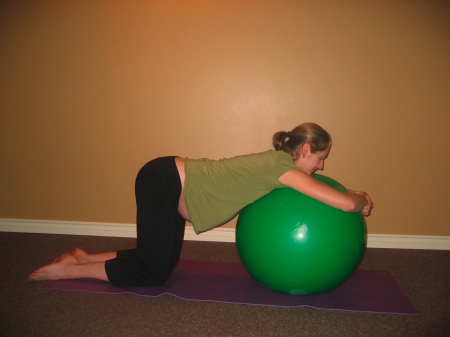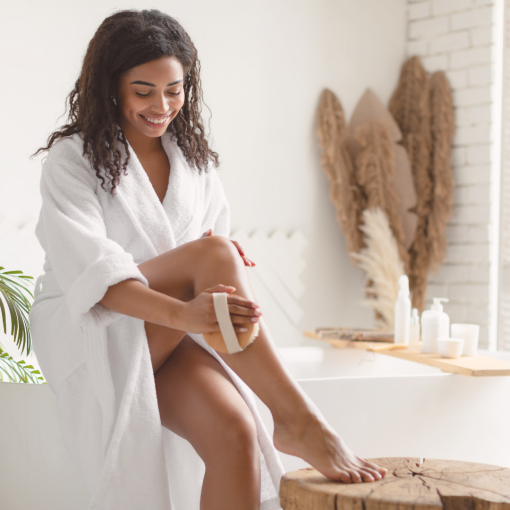I wish that no one needed this post. Varicosities or varicose veins are bad enough when they happen on your legs. They suck even more when they happen in your vagina.
However there are some simple and safe yoga movements that you can do to help alleviate some of the discomfort that they cause.

First let’s start with a brief description of why women experience varicosities during pregnancy:
Varicose veins in pregnancy are a result of a growing uterus that puts pressure on the inferior vena cava, increasing pressure in the leg/vaginal veins; increased blood volume that causes the veins to work harder; and increased progesterone levels that cause the walls of the blood vessels to relax.
Note that deep, prolonged squats can aggravate varicosities during pregnancy, so these poses should be avoided. You may want to avoid the squatting position during birth as well. Hands and knees (in all fours) or side-lying would be alternative good birth positions.
Here are some yoga poses that are especially beneficial for vaginal varicosities during pregnancy:
Viparita Karani (Legs Up the Wall)* for 3-5 minutes
- Place bolster or several pillows several inches from wall
- Sit sideways on bolster or pillows
- Hands on mat in front of bolster or pillows
- Bend elbows and lay torso on mat
- Shift lower hip closer to the wall
- Roll onto back
- Top of bolster or pillows rest just under lower ribs
- Arms out to sides with palms up
More detailed instructions and photo: http://www.yogajournal.com/poses/ 690
Benefits:
- Reduces fatigue
- Relieves swelling/varicosities in feet/legs/vulva and hemorrhoids
- May help with night cramps in legs due to pooling of blood in lower legs
Caution If you feel dizzy, lightheaded or nauseous during this pose, roll out and onto your left side. *Please see note at the end of this post.
Prasarita Padottanasana (Wide-Legged Forward Bend)
- Feet are about 2 or 3 feet wide
- Toes facing forward
- Inhale, raise the arms up
- Exhale, hinge at the hips and fold forward
- Rest hands on thighs, shins, blocks or mat
- Keep knees bent if you need to
- Lift sit bones to ceiling
- Rotate inner thighs out
- Hug your baby towards spine
More detailed instructions and photo: http://www.yogajournal.com/poses/693
Benefits:
- Strengthens legs
- Relieves lower backache
- Shifts baby and takes pressure off pelvic floor and organs
Uttanasana (Forward Fold)
- Feet a little wider than hips
- Toes facing forward
- Inhale, hug baby towards spine
- Exhale, hinge at the hips and bend forward
- Clasp the elbows
- Press sit bones up towards ceiling
- Keep knees bent if you need to
More detailed instructions and photo: http://www.yogajournal.com/poses/478
Benefits:
- Strengthens legs
- Relieves lower backache
- Shifts baby and takes pressure off pelvic floor and organs
Note about the supine position
*Much controversy exists about exercising in the supine position during pregnancy after 20 weeks, and the concept of supine hypotension has created a fear in many pregnant women that they are doing their babies harm if they wake up and find themselves lying on their back. Most women who are experiencing a significant decrease in blood flow to the heart will experience sensations of shortness of breath or pressure in the chest, leading them to instinctively move out of that posture, whether they are awake or asleep. Studies have shown no adverse effects for three to five minutes of exercise in the supine position. Pregnant women often spend the same amount of time in a supine position each time they visit their care providers (doctor or midwife) during pregnancy.
Elizabeth Noble, who has been teaching prenatal exercise classes for over thirty years, has found that no more than 5% of her students are uncomfortable in the supine position for short durations. Another noted prenatal exercise instructor, Ann Cowlin, finds that approximately 1 woman in 30 declines to perform exercises in this position. These practitioners feel that if pregnant women are encouraged to come out of supine postures that are not comfortable, they will do so, and they will willingly stay in supine postures that offer them comfort or benefit.
I explain to my yoga students that if they feel dizzy, nauseous or short of breath to come out of the pose. I also explain that gravity is working with them to help the blood flow back to the heart, especially since the hips and lower back are lifted with a bolster or pillows.
*******************
Other alternative therapies is include increasing vitamin C consumption, and using essential oils and acupuncture. Please consider contacting an acupuncturist to help you feel better. Send me an email if you’d like my essential oil recommendations.






6 thoughts on “Yoga for Vaginal Varicosities”
I’d love to know your essential oils of choice to help. I’m in such pain. Would you recommend these 2 yoga moves daily?
Hi Bri! Yes definitely it would be helpful to do those two yoga moves daily. The essential oils that are recommended are cypress and lavender. You can add a drop of each to epsom salts and place in your bathwater to soothe and to assist in toning the circulation. You can also add one drop of each to a tablespoon of carrier oil such a coconut oil or olive oil, and gentle massage over the legs and pelvis.
Hi, what essential oils would you recommend in a sitz bath for my 32 week pregnant friend, she is struggling with the vulva varicose veins and in extreme pain.
Thank you 🙂
Lavender is very gentle and has a long history of use during pregnancy. It’s nickname is “All Things Calming”. So if your friend is looking for a soothing essential oil – this one would be my first choice. Just make sure that what you are using with pure high quality essential oils. You can learn more here: https://birthbliss.ca/essential-oils/
What essential oils are recommended for vaginal varicosities? I am a 58 year old women who had 1 child and had a hysterectomy. It was discovered that I have vaginal varicosity when I was examined for prolapse of my bladder. I am doing exercises to strengthen my pelvic floor.
Hi Lenora!
The essential oils that I’ve found to be the most effective for vaginal varicosities is a mixtures of cypress and lemongrass and peppermint that are highly diluted with fractionated coconut oil. The mixture I would use is 7 drops cypress, and 7 drops lemongrass and 7 drops peppermint topped with fractionated coconut oil in a 10ml container.
Here are the oils that I love and recommend: https://doterra.me/5lEewM
And finally I just created a Guide to Using Essential Oils Safely – if you would like a copy, just drop me an email at marie.berwald@birthbliss.ca
All the best!